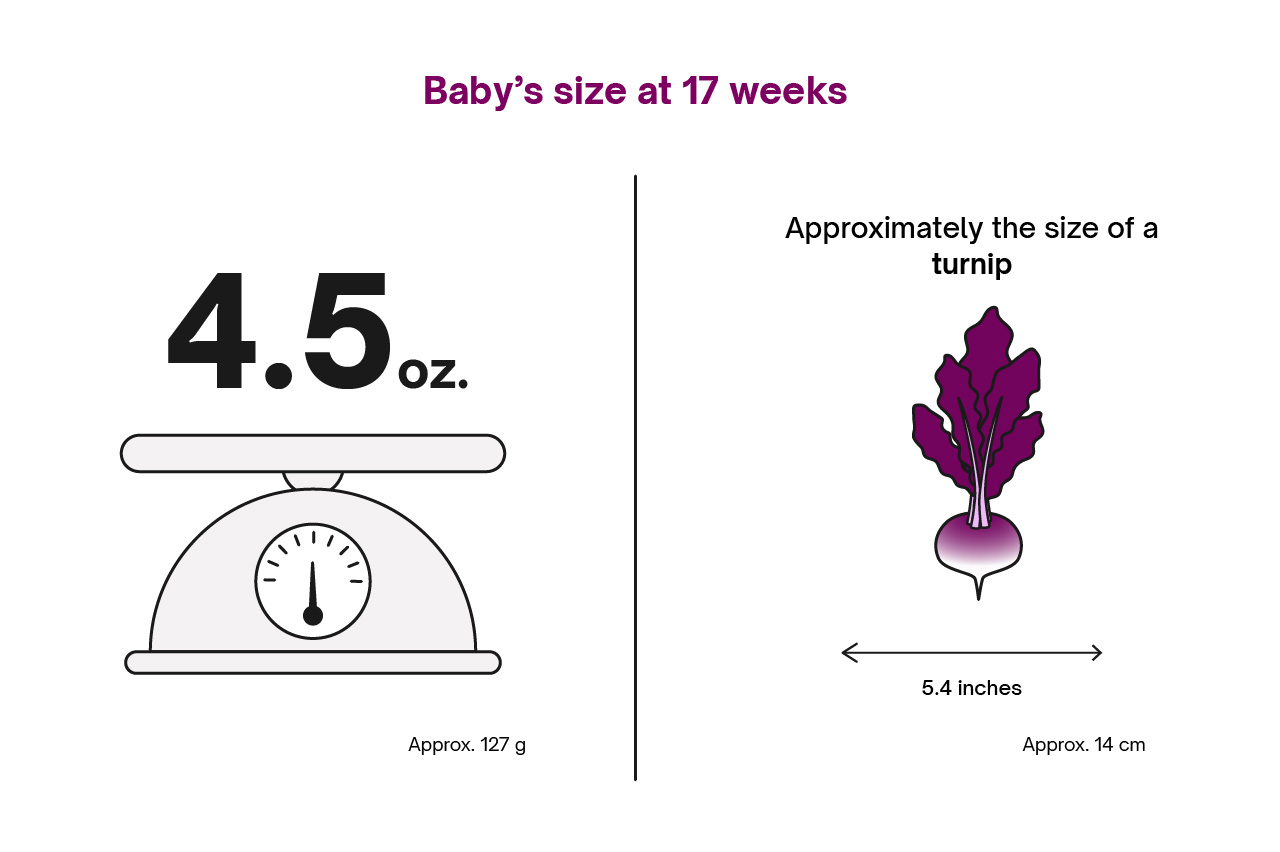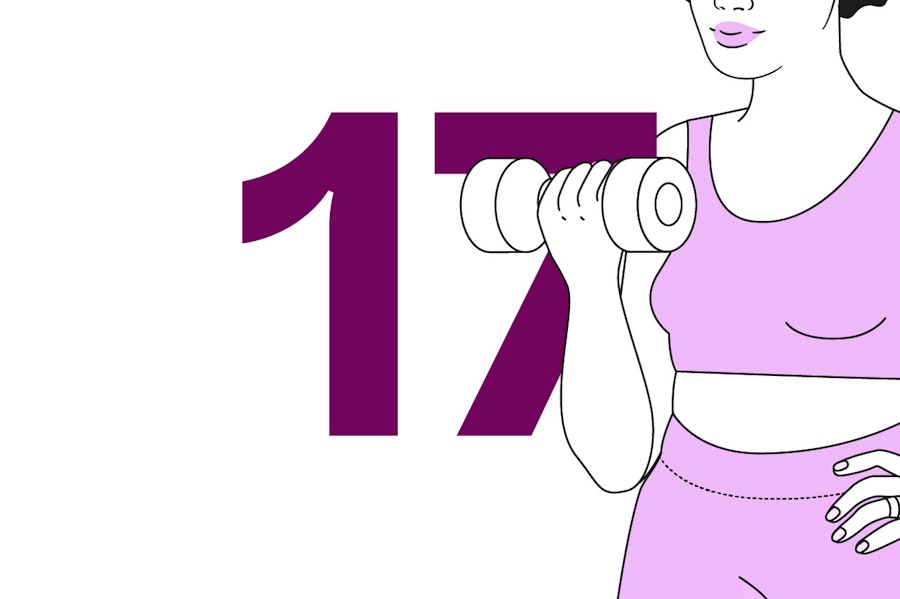17 Weeks pregnant: Stretch marks, symptoms, baby size & more
Follows NC° Editorial Policy
At Natural Cycles, our mission is to empower you with the knowledge you need to take charge of your health. At Cycle Matters, we create fact-checked, expert-written content that tackles these topics in a compassionate and accessible way. Read more...
Key takeaways:
- Stretch marks are the result of your growing, changing body, and affect up to 90% of all pregnant women
- A balanced, healthy diet and regular light to moderate exercise can help ensure you are supporting your own and your baby’s health as you gain weight during pregnancy
- Weird, vivid, or scary dreams are more common in the second trimester, with studies suggesting that dreaming is your body’s way of processing the enormous emotional and psychological changes you are experiencing in your pregnancy
Welcome to week 17 of your pregnancy! In this week’s article, we will dive deep into two important body changes you might become more aware of this week. We will also check in on how your baby is doing and touch on some pregnancy symptoms you might experience in the second trimester. Finally, we will offer some tips on things you can do this week to ensure you are caring for your body and mind.
Your body at week 17
Stretch marks
It is estimated that up to 90% of women develop stretch marks, or striae gravidarum, during pregnancy [1]. They most often appear on the breasts and stomach, but can also develop on the butt, hips, and thighs. They can be narrow or wide and white, pink, red, purple, or brown, depending on your natural skin pigmentation. After your baby is born, stretch marks might gradually fade or become paler, but they likely will not go away completely. Stretch marks are not known to cause any medical harm to you, or your baby. Though they are a sign of the amazing things your body is doing, it is also normal to find their them stressful or distressing.
There are two main factors that cause stretch marks. The first is the physical stretching of the skin as your stomach and breasts grow and you gain weight during pregnancy. This stretching can damage the connective tissue in your top layer of skin, causing small tears and scars that appear as stretch marks. Scientists have also hypothesized that certain hormones you produce when pregnant decrease the production of collagen and elastin in the skin, making it more difficult for your body to repair tears in the connective skin tissues [1].
Scientists have suggested a number of additional factors that influence if and how you develop stretch marks. These include maternal factors like age, personal history, body mass index, skin color, and race, as well as pregnancy factors relating to weight gain, increases in body mass index, and if you have lower levels of serum vitamin C and serum relaxin [1]. Relaxin is a hormone produced by the body specifically during pregnancy that helps to relax muscles, joints, and ligaments, and helps the body stretch as the baby grows and you prepare to give birth. Your baby’s size and weight during gestation and delivery can also affect stretch mark development.
While there are products that are marketed to reduce or treat stretch marks, there is unfortunately no evidence
that stretch marks can be prevented or significantly reduced during pregnancy. Early studies have suggested that topical creams containing centella may be effective for reducing or preventing stretch marks, though more research is needed [1]. While stretch marks are a normal and common part of most pregnancies, there are treatments and products that can be used to help minimize or reduce their appearance postpartum, if that’s something you want to do. Treatments for stretch marks include laser therapy, light therapy, microneedling, and retinoids. If you are interested in exploring these options, we recommend consulting with a healthcare provider to understand what options might be best suited to you.
Weight gain
If your appetite has returned after the first trimester, or if you find you are hungrier than normal now in your second trimester, you might be wondering what is considered healthy weight gain during pregnancy. Everyone’s pregnancy is different and studies have shown that total weight change during pregnancy can vary widely – from weight loss to a gain of more than 66 pounds (30 kilograms) – and is affected by many different factors [2].
In general, weight gain is considered a combination of two parts: the weight of the baby, placenta, and amniotic fluid, and the expansion of maternal tissues. Scientists estimate that the baby accounts for about 25% of the total gain, with the placenta representing about 5% and the amniotic fluid about 6% [2]. Increased blood volume during pregnancy is responsible for about 10% of your weight gain, while increased fluid volume in the cells and muscles can account for up to 13% of total weight gain [2].
The US Center for Disease Control (CDC) and American College of Obstetricians and Gynecologists (ACOG) both suggest that weight gain recommendations during pregnancy be based on your body mass index, or BMI, before pregnancy [3,4]. It is also important to note that recommendations are different if you have a single or multiple pregnancy (e.g., twins). Depending on your BMI, the recommendations of weight gain in the second and third trimesters vary from 0.5 pounds (if your BMI is over 30) to around 1 pound a week [4]. While no extra calories are generally required in the first trimester, it is recommended to consume around 340 additional calories per day in the second trimester and around 450 calories per day in the third trimester [4].
A balanced, healthy diet and light to moderate aerobic activity (if safe to do so in your pregnancy), ensure that your body is getting the nutrition and exercise it needs to help you and your baby stay healthy during pregnancy. Check out our tips for exercise during pregnancy and what to eat when pregnant for more information.
Your baby’s development at 17 weeks
During week 17, your baby’s bones are hardening, and their muscle tissues are continuing to develop. Your baby’s ears have reached their final position, and hearing is maturing, while the umbilical cord, which connects the baby to the placenta, is getting longer and thicker [5].
Your baby weighs between 4 and 4.9 ounces (110 to 140 grams) and measures around 5.1 to 5.75 inches (13 to 14.5 centimeters) long this week [5]. This is around the size of a turnip!

Pregnancy Symptoms in week 17
Itchiness
Skin itchiness is a common pregnancy symptom in the second trimester. Stretched skin on your growing body and stretch marks can cause itchiness on the breasts, abdomen, hips, and thighs. It is also possible to experience itchiness elsewhere. Increased blood supply, hormones, and dehydration can all contribute to dry, itchy skin. Try to opt for natural, breathable fabrics and use a body moisturizer regularly to treat dry skin and prevent irritation.
In rare cases, itchiness can be a sign of a rare, potentially serious liver condition called intrahepatic cholestasis of pregnancy (ICP). ICP tends to be more common in women of South Asian origin and is also more common if you have had ICP in a previous pregnancy [6]. If you experience itching (usually without a rash) that is more noticeable on the palms of the hands and the soles of the feet or is worse at night, contact your healthcare provider. Other symptoms of ICP can include dark urine, pale poop, and jaundice (yellowing of the skin and whites of the eyes).
Weird or vivid dreams
You might notice that your dreams are changing this week. This can include having more vivid, intense, or frequent dreams than what is normal for you. Anxiety-based, sexual, or scary dreams are all common. Your body is going through dramatic emotional, physical, and mental changes, which can all affect your dream patterns.
While scientists are unsure what exactly causes these changes, an increase in hormone production is believed to impact the way your brain processes information and emotions throughout your day [7]. Studies have suggested that the frequency of dreams and nightmares might also depend on your individual sleep patterns during pregnancy [8]. If you find you are sleeping longer, or deeper, in your second trimester, this might contribute to more vivid dreams or dreams that you can remember the next day. Though you might find these changes startling, or even worrying, remember that dreams are your body’s way of regulating emotions and dealing with stress, fears, and anxieties. Keeping a dream diary can be a good tool to help you process your dreams, as well as a keepsake to remember what you experienced after pregnancy.
Tips in week 17
- Stay hydrated, inside and out: drinking enough water daily remains very important, but you might also notice your skin is dryer than normal. Consider using body moisturizers or lotions regularly to help avoid skin irritation on account of dryness.
- Start practicing relaxation and deep breathing techniques: it is never too early to start practicing relaxation and breathing techniques. Not only can these help during childbirth, but they can also come in handy throughout your pregnancy as you navigate changes to your mental and physical health.
- Stick to breathable fabrics: your body is making extra fluids, including perspiration and vaginal discharge. If you notice excessive sweat under your arms or are experiencing a lot of vaginal discharge, try switching to breathable natural fabrics like cotton or linen to keep you dry and comfortable. An extra layer of deodorant and a pantyliner can also help.
- Strengthening your pelvic floor: starting regular pelvic floor exercises can help you throughout your pregnancy and in childbirth. A strong pelvic floor can help prevent leaking urine when you sneeze or cough, aid pelvic and hip discomfort, and has been shown to support your body in labor and in postpartum recovery.
Natural Cycles during pregnancy
Did you know that you can use NC° Follow Pregnancy to stay up-to-date on your health and your baby’s development throughout your pregnancy? Weekly guides and reference articles help you monitor the progression of your pregnancy, while symptom trackers offer a tool for logging your pregnancy symptoms. It's all part of Natural Cycles’ mission to empower every woman with the knowledge she needs to take charge of her reproductive health. Learn how Natural Cycles can support you today!
Did you enjoy reading this article?
